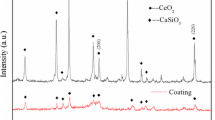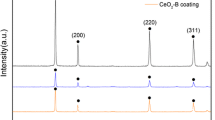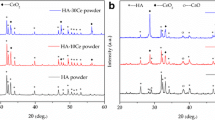Abstract
Oxidative stress is a risk factor in the pathogenesis of osteoporosis, and plays a major role in bone regeneration of osteoporotic patients. Cerium oxide (CeO2) ceramics have the unique ability to protect various types of cells from oxidative damage, making them attractive for biomedical applications. In this study, we developed a plasma sprayed CeO2 coating with a hierarchical topography where ceria nanoparticles were superimposed in the micro-rough coating surface. The protective effects of the CeO2 coating on the response of osteoblasts to H2O2-induced oxidative stress have been demonstrated in terms of cell viability, apoptosis and differentiation. The CeO2 coating reversed the reduced superoxide dismutase activity, decreased reactive oxygen species production and suppressed malondialdehyde formation in H2O2-treated osteoblasts. It indicated that the CeO2 coating can preserve the intracellular antioxidant defense system. The cytocompatibility of the CeO2 coating was further assessed in vitro by cell viability assay and scanning electron microscopy analysis. Taken together, the CeO2 coating could provide an opportunity to be utilized as a potential candidate for bone regeneration under oxidative stress.











Similar content being viewed by others
References
Geetha M, Singh AK, Asokamani R, Gogia AK. Ti based biomaterials, the ultimate choice for orthopaedic implants—a review. Prog Mater Sci. 2009;54(3):397–425.
Marco F, Milena F, Gianluca G, Vittoria O. Peri-implant osteogenesis in health and osteoporosis. Micron. 2005;36(7–8):630–44.
Otomo-Corgel J. Osteoporosis and osteopenia: implications for periodontal and implant therapy. Periodontol. 2000;2012(59):111–39.
Wauquier F, Leotoing L, Coxam V, Guicheux J, Wittrant Y. Oxidative stress in bone remodelling and disease. Trends Mol Med. 2009;15(10):468–77.
Wang X, Gu CS, He W, Ye XL, Chen HL, Zhang XD, et al. Glucose oxidase induces insulin resistance via influencing multiple targets in vitro and in vivo: the central role of oxidative stress. Biochimie. 2012;94(8):1705–17.
Lee DH, Lim BS, Lee YK, Yang HC. Effects of hydrogen peroxide (H2O2) on alkaline phosphatase activity and matrix mineralization of odontoblast and osteoblast cell lines. Cell Biol Toxicol. 2006;22(1):39–46.
Jung WW. Protective effect of apigenin against oxidative stress-induced damage in osteoblastic cells. Int J Mol Med. 2014;33(5):1327–34.
Ball JP, Mound BA, Monsalve AG, Nino JC, Allen JB. Biocompatibility evaluation of porous ceria foams for orthopedic tissue engineering. J Biomed Mater Res A. 2015;103(1):8–15.
Karakoti AS, Monteiro-Riviere NA, Aggarwal R, Davis JP, Narayan RJ, Self WT, et al. Nanoceria as antioxidant: synthesis and biomedical applications. Jom. 2008;60(3):33–7.
Deliormanlı AM. Synthesis and characterization of cerium-and gallium-containing borate bioactive glass scaffolds for bone tissue engineering. J Mater Sci Mater Med. 2015;26(2):1–3.
Celardo I, Pedersen JZ, Traversa E, Ghibelli L. Pharmacological potential of cerium oxide nanoparticles. Nanoscale. 2011;3(4):1411–20.
Pulido-Reyes G, Rodea-Palomares I, Das S, Sakthivel TS, Leganes F, Rosal R, et al. Untangling the biological effects of cerium oxide nanoparticles: the role of surface valence states. Sci Rep. 2015;5:15613.
Karakoti AS, Tsigkou O, Yue S, Lee PD, Stevens MM, Jones JR, et al. Rare earth oxides as nanoadditives in 3-D nanocomposite scaffolds for bone regeneration. J Mater Chem. 2010;20(40):8912–9.
Pagliari F, Mandoli C, Forte G, Magnani E, Pagliari S, Nardone G, et al. Cerium oxide nanoparticles protect cardiac progenitor cells from oxidative stress. ACS Nano. 2012;6(5):3767–75.
Zhang WJ, Wang GC, Liu Y, Zhao XB, Zou DH, Zhu C, et al. The synergistic effect of hierarchical micro/nano-topography and bioactive ions for enhanced osseointegration. Biomaterials. 2013;34(13):3184–95.
Niu YR, Wang HY, Huang LP, Li H, Liu XY, Zheng XB, et al. Oxidation and ablation resistance of low pressure plasma-sprayed ZrB2-Si composite coating. J Therm Spray Technol. 2014;23(3):470–6.
Yang K, Zhou XM, Liu CG, Tao SY, Ding CX. Sliding wear performance of plasma-sprayed Al2O3-Cr2O3 composite coatings against graphite under severe conditions. J Therm Spray Technol. 2013;22(7):1154–62.
Wang GC, Lu ZF, Liu XY, Zhou XM, Ding CX, Zreiqat H. Nanostructured glass-ceramic coatings for orthopaedic applications. J R Soc Interface. 2011;8(61):1192–203.
Gittens RA, McLachlan T, Olivares-Navarrete R, Cai Y, Berner S, Tannenbaum R, et al. The effects of combined micron-/submicron-scale surface roughness and nanoscale features on cell proliferation and differentiation. Biomaterials. 2011;32(13):3395–403.
Li YF, Fu Q, Qi YP, Shen MM, Niu Q, Hu KJ, et al. Effect of a hierarchical hybrid micro/nanorough strontium-loaded surface on osseointegration in osteoporosis. Rsc Adv. 2015;5(65):52296–306.
Li K, Yu JM, Xie YT, Huang LP, Ye XJ, Zheng XB. Chemical stability and antimicrobial activity of plasma sprayed bioactive Ca2ZnSi2O7 coating. J Mater Sci Mater Med. 2011;22(12):2781–9.
Huang YL, Lee CH, Liao JF, Liu YW, Chiou WF. Protective effects of ugonin K on hydrogen peroxide-induced osteoblast cell damage. J Funct Foods. 2015;15:487–96.
Li K, Yu JM, Xie YT, Huang LP, Ye XJ, Zheng XB. Effects of Zn content on crystal structure, cytocompatibility, antibacterial activity, and chemical stability in Zn-modified calcium silicate coatings. J Therm Spray Technol. 2013;22(6):965–73.
Zheng XB, Huang MH, Ding CX. Bond strength of plasma-sprayed hydroxyapatite/Ti composite coatings. Biomaterials. 2000;21(8):841–9.
Zhao XB, Liu GP, Zheng H, Cao HL, Liu XY. Dose-dependent effects of CeO2 on microstructure and antibacterial property of plasma-sprayed TiO2 coatings for orthopedic application. J Therm Spray Technol. 2015;24(3):401–9.
Wang YJ, Dong H, Lyu GM, Zhang HY, Ke J, Kang LQ, et al. Engineering the defect state and reducibility of ceria based nanoparticles for improved anti-oxidation performance. Nanoscale. 2015;7(33):13981–90.
Zhang JH, Zhu YF. Synthesis and characterization of CeO2-incorporated mesoporous calcium-silicate materials. Microporous Mesopoousr Mater. 2014;197:244–51.
Leonelli C, Lusvardi G, Malavasi G, Menabue L, Tonelli M. Synthesis and characterization of cerium-doped glasses and in vitro evaluation of bioactivity. J Non Cryst Solids. 2003;316(2–3):198–216.
Finkel T, Holbrook NJ. Oxidants, oxidative stress and the biology of ageing. Nature. 2000;408(6809):239–47.
Gardner AM, Xu FH, Fady C, Jacoby FJ, Duffey DC, Tu YP, et al. Apoptotic vs nonapoptotic cytotoxicity induced by hydrogen peroxide. Free Radical Bio Med. 1997;22(1–2):73–83.
Palomba L, Sestili P, Columbaro M, Falcieri E, Cantoni O. Apoptosis and necrosis following exposure of U937 cells to increasing concentrations of hydrogen peroxide: the effect of the poly(ADP-ribose)polymerase inhibitor 3-aminobenzamide. Biochem Pharmacol. 1999;58(11):1743–50.
Hosoya S, Suzuki H, Yamamoto M, Kobayashi K, Abiko Y. Alkaline phosphatase and type I collagen gene expressions were reduced by hydroxyl radical-treated fibronectin substratum. Mol Genet Metab. 1998;65(1):31–4.
Naganuma T, Traversa E. Stability of the Ce3+ valence state in cerium oxide nanoparticle layers. Nanoscale. 2012;4(16):4950–3.
Celardo I, De Nicola M, Mandoli C, Pedersen JZ, Traversa E, Ghibelli L. Ce3+ ions determine redox-dependent anti-apoptotic effect of cerium oxide nanoparticles. ACS Nano. 2011;5(6):4537–49.
Xiao Y, Li X, Cui YQ, Zhang J, Liu LJ, Xie XY, et al. Hydrogen peroxide inhibits the proliferation and endothelial differentiation of bone marrow stem cells partially through reactive oxygen species generation. Life Sci. 2014;112(1–2):33–40.
Ando T, Mimura K, Johansson CC, Hanson MG, Mougiakakos D, Larsson C, et al. Transduction with the antioxidant enzyme catalase protects human T cells against oxidative stress. J Immunol. 2008;181(12):8382–90.
Halliwell B. Role of free radicals in the neurodegenerative diseases—therapeutic implications for antioxidant treatment. Drug Aging. 2001;18(9):685–716.
Heckert EG, Karakoti AS, Seal S, Self WT. The role of cerium redox state in the SOD mimetic activity of nanoceria. Biomaterials. 2008;29(18):2705–9.
Bhushan B, Gopinath P. Antioxidant nanozyme: a facile synthesis and evaluation of the reactive oxygen species scavenging potential of nanoceria encapsulated albumin nanoparticles. J Mater Chem B. 2015;3(24):4843–52.
Zhao LZ, Wang HR, Huo KF, Zhang XM, Wang W, Zhang YM, et al. The osteogenic activity of strontium loaded titania nanotube arrays on titanium substrates. Biomaterials. 2013;34(1):19–29.
Naganuma T, Traversa E. The effect of cerium valence states at cerium oxide nanoparticle surfaces on cell proliferation. Biomaterials. 2014;35(15):4441–53.
Acknowledgments
This work was supported by the National Natural Science Foundation of China (Grant Nos. 51502328, 81301537, 81300917).
Author information
Authors and Affiliations
Corresponding author
Electronic supplementary material
Below is the link to the electronic supplementary material.
Rights and permissions
About this article
Cite this article
Li, K., Xie, Y., You, M. et al. Plasma sprayed cerium oxide coating inhibits H2O2-induced oxidative stress and supports cell viability. J Mater Sci: Mater Med 27, 100 (2016). https://doi.org/10.1007/s10856-016-5710-9
Received:
Accepted:
Published:
DOI: https://doi.org/10.1007/s10856-016-5710-9




